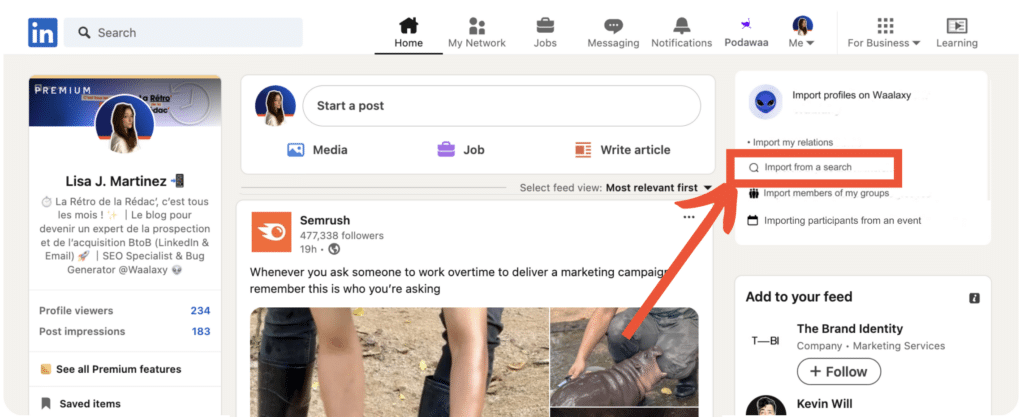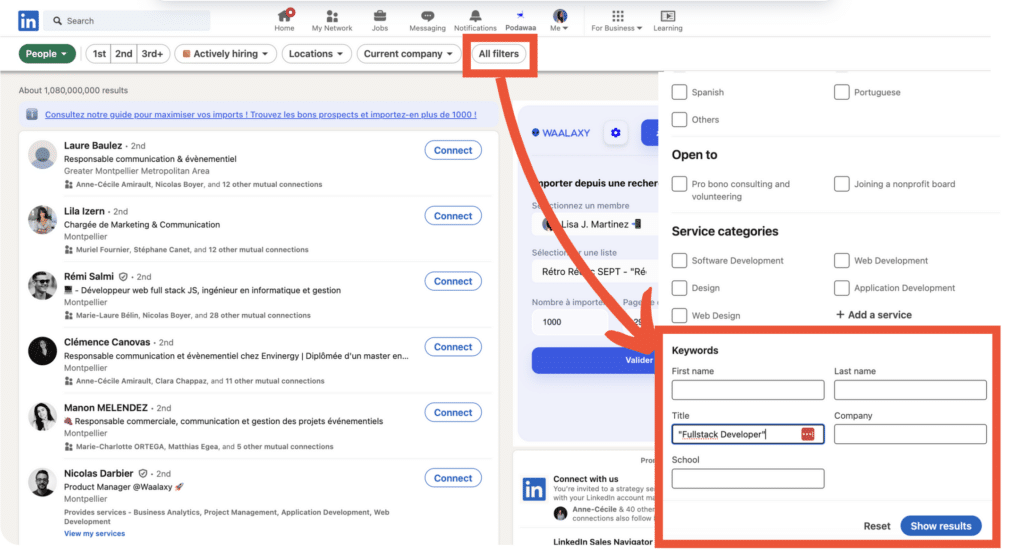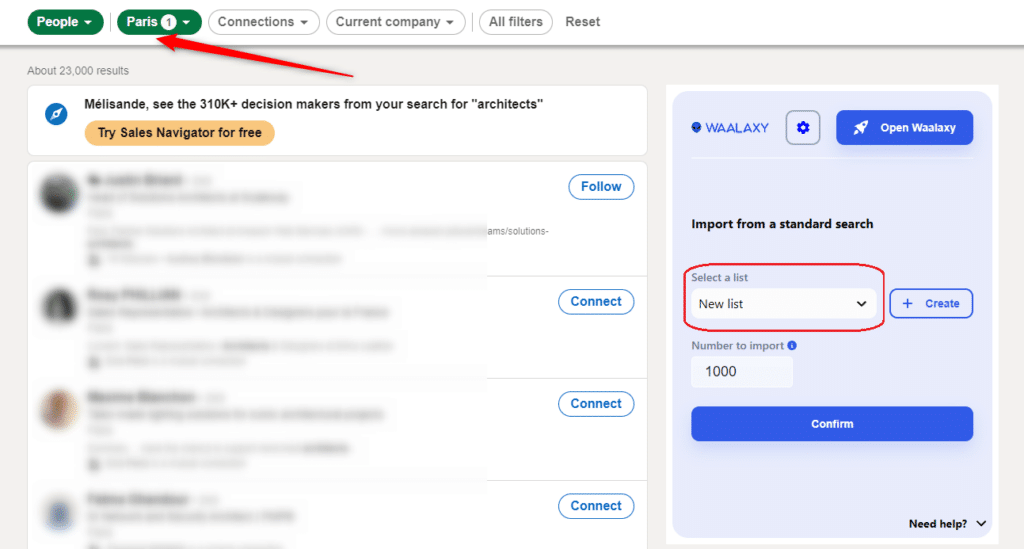Recently, LinkedIn scraping has become enormously popularized, not least with the arrival of tools that make possible a practice previously reserved for developers.
In this article, I explain how to scrap LinkedIn, without being a developer. 😜
What is data scraping?
Web scraping is a computer technique for systematically retrieving information or databases from a web page in order to reuse them in another context. 👆
This is a technique for automatically extracting data from a website using a script or software. 🤖 It helps collect information (text, images, contacts) for reuse, often for tracking, analysis or prospecting purposes.
Although powerful, data collection is regulated by legal rules and many sites, including LinkedIn, may prohibit its use without authorization.
Why do LinkedIn Data Scraping?
Data scraping activities allow you to retrieve valuable information from the Internet. 🌐
For example, to build up a prospecting file, or to find out about your competitors.
Scraping on LinkedIn enables you to gather key information on professional profiles to optimize searches and recruitment. 🔍
Companies and freelancers can thus identify customers, potential partners or qualified candidates on a large scale, ✨ while accessing up-to-date data from LinkedIn (name, location, company, domain).
A LinkedIn scraper also makes it easy to analyze industry trends or conduct accurate market research. 🕵️
For sales teams, this data facilitates the personalization of marketing campaigns and better targeting on LinkedIn, making sales approaches more effective. 💯 Be careful, however, to respect LinkedIn’s rules and CGU!
Does LinkedIn allow Scraping?
LinkedIn explicitly prohibits the collection of its data. 🙊 Its Terms of Service stipulate that the use of software or scripts to extract data is prohibited…
In France, the CNIL has imposed fines on companies that use information gathering on LinkedIn without the prior consent of the people concerned, underlining the importance of complying with the applicable regulations.
However, there are a few exceptions to the rule. 🪄 For example, you can take advantage of LinkedIn’s user base of over 875 million members by harvesting information from members’ public profiles. And, it’s perfectly legal! 💥
Find out more about our Use of Data policies here!
How to do LinkedIn scraping?
To set up LinkedIn scraping, start by defining your goals and targeting specific profiles or companies. 🎯
Use the best reliable scraping tool like Waalaxy or Sales Navigator to automate queries and segment results. 📍
Not a developer and still want to scrape LinkedIn? 😏
No problem, I’ll show you how to scrape LinkedIn using Waalaxy, in just a few easy steps!
How to use LinkedIn data scraping tool?
Let’s say you want to scrape the e-mails of your LinkedIn relations. 👉 It’s very simple:
Go to LinkedIn and click on “Import from a search” via Waalaxy’s Chrome extension.

- Sort results by “People”, then go to “All filters” to add your keywords. 💫

- Create a campaign by clicking on “Select a list”, then select the number of profiles you want to scrape.
- Finally, click on “Validate”.

The profiles will be exported to Waalaxy. 👽 Once the export is complete, all you have to do is download your contacts’ info in CSV format from Waalaxy.
Once on the Waalaxy CRM: 👇
- Click on “Prospect list”,
- Then select the previously created campaign. There you’ll find the profiles you’ve just exported.
- To obtain the file containing all the information, select all the profiles, then click on “Export”, check your e-mail and validate.
You’ll get a CSV file containing first name/last name/email address/company/post/LinkedIn premium or not/region/link to LinkedIn profile/phone number.
When importing leads, Waalaxy scans each lead and can detect leads already present in the tool, whether in one of your lists or in the list of one of your team members. 🕵️♂️
It is therefore unlikely that a lead will appear twice in the tool, in the list or in a campaign. 😍
If you’d like to know more about our anti-dubbing control for lead generation, then this is the article for you. 💖
Here’s a simple and secure way to export all your data! 😜

This way, you can scrape hundreds of pages of people’s searches on LinkedIn.
On the other hand, you won’t get the emails of your prospects if you’re not connected with them. 📩 Read this article to find the emails of prospects you’re not connected with.
LinkedIn Data Scraping: 4 best advices
LinkedIn scraping should be approached with caution to avoid the platform’s limitations. 🤫 Here are some best practices for effective and secure data collection:
- Segment your search: targeting specific areas, places, experiences or locations will refine your results. 📍 LinkedIn or Sales Navigator offer advanced search filters to segment by company, seniority or experience level.
- Limit frequency: LinkedIn imposes limits and can suspend accounts that make excessive requests. 🥵 Schedule weekly scraping sessions to keep a low profile.
- Automate intelligently: use reliable tools (like Waalaxy) 👽 and configure daily quotas to mimic human browsing (latency, random waiting period).
- Respect personal data: avoid collecting sensitive information and respect the LinkedIn data scraping is accessible on public profiles according to the terms of use.
See also our tips on how to do a good search on LinkedIn! ⚡
What to do with my Scraped LinkedIn Profiles?
Once you’ve scraped your LinkedIn profiles, you can synchronize them with tools such as HubSpot and Waalaxy to optimize your search campaigns: ⏬
- Import the profile into HubSpot: prepare a CSV file with key information (name, company, position, LinkedIn URL, etc.). 🔗 In HubSpot, go to “Contacts” > “Import” and select your file to create a complete contact record, which will enable you to track prospects more easily.
- Connect Waalaxy to HubSpot: make sure Waalaxy and HubSpot are integrated (via Zapier or directly). This will automatically synchronize contacts from Waalaxy to HubSpot. 👉 Set up synchronization so that every new Waalaxy lead appears in HubSpot with integrated tracking.
- Launch a campaign in Waalaxy: in Waalaxy, select the imported profile to create a new campaign. Choose the type of sequence (connection, message, etc.) and customize the message for maximum impact. 💥 Waalaxy manages automation while retaining a personalized approach, enabling automated invitations and follow-up messages to be sent to scraped profiles.
There you go, LinkedIn scraping is child’s play, isn’t it 😉
Follow our complete guide to LinkedIn prospecting for your business here!⚡
What are the legal restrictions of LinkedIn scraping?
Indeed, it is normal to wonder about the legality of LinkedIn scraping. 🧐 Nowadays, we are increasingly concerned about data protection and these processes are often not compliant with the General Data Protection Regulation (GDPR).
In reality, several factors must be taken into account in this consideration.
Of course, the data retrieved must be publicly accessible. According to LinkedIn’s terms of use, the use of data for commercial purposes via “web scraping” is not permitted. 😬
The consent of the parties involved must be considered when collecting data. If you want to collect information to send by email, you must first obtain the person’s consent. 📩 Otherwise, they must already be a customer of your company.
Otherwise, you are not allowed to contact them for commercial reasons. A person’s right to opt-out must also be respected via an unsubscribe link. In the context of direct marketing, data retention periods must be respected. 🙏
Indeed, this data can only be kept for three years after its collection or after the last contact from the other party. 📅 Finally, you must comply with the GDPR or computer fraud and abuse act. This means limiting data collection, informing data subjects and addressing scraping processes (including investigating privacy implications).
Therefore, although LinkedIn officially prohibits web scraping, the practice remains a major challenge due to privacy regulations. 🤫
However, technically, this does not stop you, and many tools specialize in LinkedIn scraping. ✅ Although web scraping is prohibited by LinkedIn, the information obtained is actually freely accessible online.
What about a recap?
LinkedIn scraping is a very powerful tool for your business. 🦾 It helps you efficiently extract data from your LinkedIn profile scraper, providing valuable information that you can use for lead generation and business development.
With the right tools and techniques, you can make the most of LinkedIn scraping! 💥
LinkedIn research provides useful data for prospecting and recruiting, but carries a few risks if it’s badly exploited. 👀
That’s why it’s important to comply with the terms of use and applicable regulations, especially to avoid restrictions. ✂️
Tools like Waalaxy make it easy to automate collection while reducing the risk of interdiction thanks to features optimized for scraping.
Find out how to start prospecting on autopilot. ✈️
In addition, a good search on LinkedIn Sales Navigator is an important first step that will determine your entire prospecting process. 🔍
The next thing to do is to extract the data and maintain its quality. Many tools allow this “scraping” step. 🤔
With our experience in implementing solutions and given our success with our customers, we recommend Waalaxy 👽 for its simplicity and its quality/price ratio, which is currently the best on the market.
To get a free trial, click on this button:
Frequently asked questions
Don’t leave so fast. We still have a few questions who may be interested you. 👀
Is LinkedIn scraping legal?
Scraping data on LinkedIn is legally complex. 🧑⚖️ In theory, the collection of public information may be permitted, but LinkedIn specifically prohibits the collection of information in its Terms of Use.
In 2019, LinkedIn filed a lawsuit against HiQ Labs for collecting public data, and the U.S. Supreme Court ruled in HiQ’s favor, allowing access to publicly available data. ⚖️
However, this still presents many risks, as LinkedIn can restrict access and even take legal action. 🤐 In Europe, the RGPD also imposes respect for users’ rights, particularly regarding consent and respect for personal data.
On the other hand, don’t panic! If you use Waalaxy, you’ll be protected thanks to our system, which mimics human actions and respects the quotas imposed by LinkedIn 😉
Can you get banned for scraping LinkedIn?
Yes, it is possible to get banned from LinkedIn for using data harvesting techniques. 🙊 LinkedIn prohibits scraping its website to extract profile data or other information.
It is therefore recommended to respect the rules established by the platform to avoid any sanctions. 👍 This way, you can scrape safely and avoid warnings!
How to scrape on LinkedIn for free?
To scrape on LinkedIn for free with Waalaxy, start by downloading Waalaxy here. ⏬
Then search LinkedIn to target your prospects yourself. 👉 Use Waalaxy to import these prospects into a dedicated list.
The free version of Waalaxy lets you send up to 80 invitations per month, making it easy to collect and manage your business contacts. 📅
There you go, I hope this article has cleared up your doubts about online data collection… Now you know how to do LinkedIn scraping without any problems! 👏













